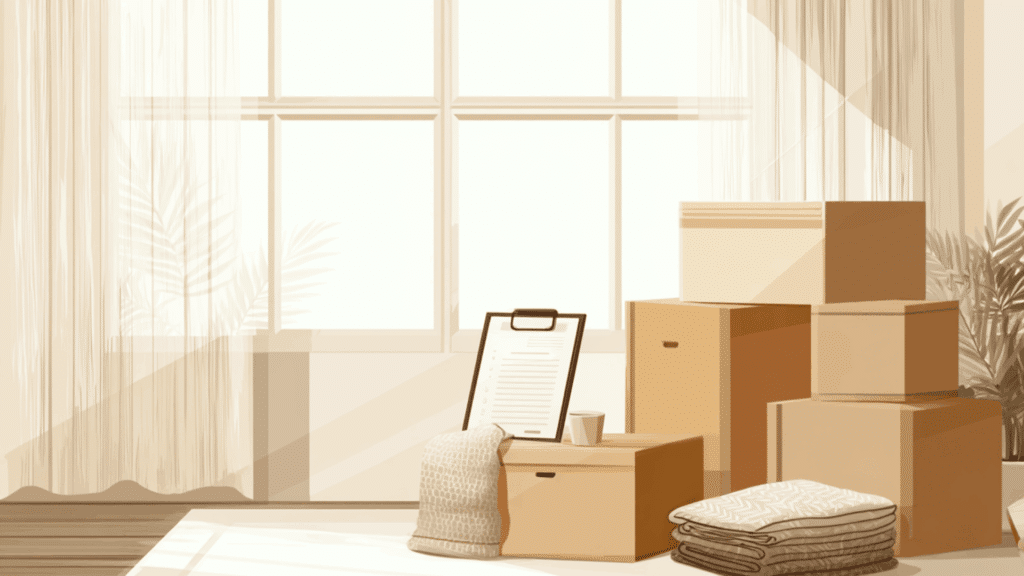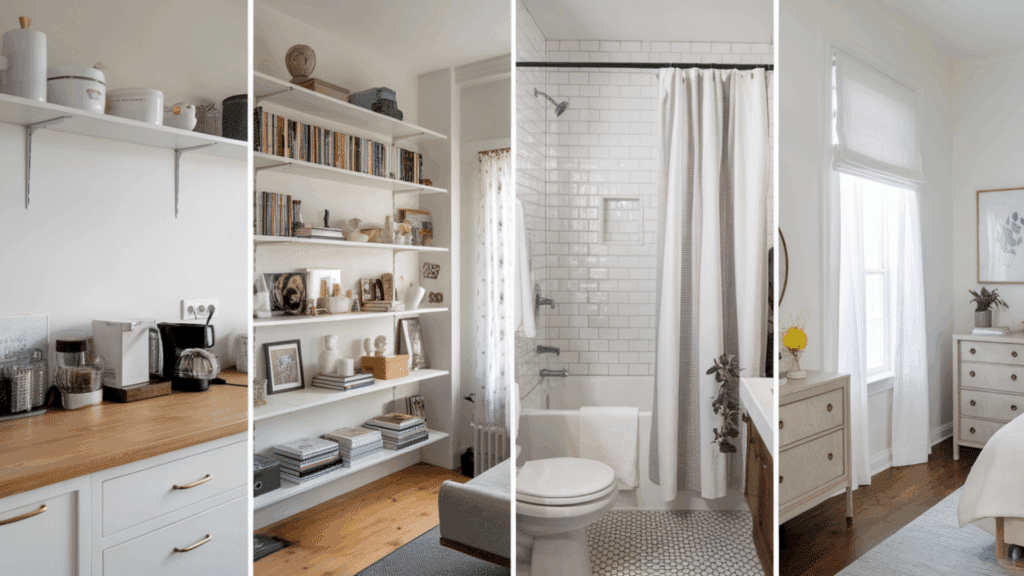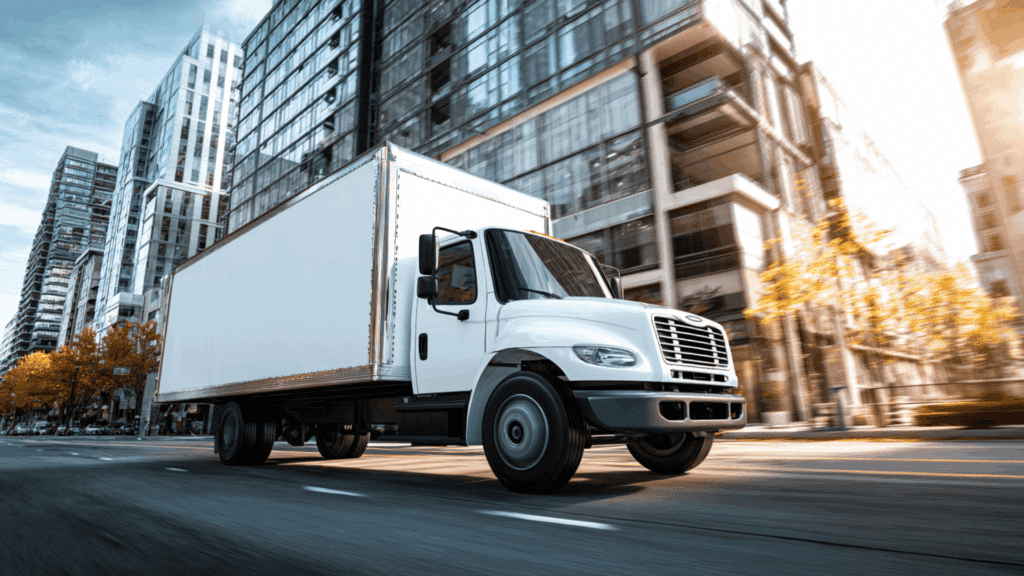If you’ve ever packed up your life and moved, you know how quickly things can get chaotic. That’s why you need a checklist when it’s time to move; it keeps everything organized, timed, and stress-free.
In this blog, you’ll find a clear timeline that walks you through every stage of your move, from early planning to unpacking in your new space.
I’ll help you stay on track, save time, and avoid last-minute surprises, all with simple, practical steps that actually work. Let’s make this move feel less overwhelming and a lot more manageable.
Why You Need a Moving Checklist
Moving can feel overwhelming, but a checklist keeps everything on track. It helps you see what needs to be done and when, so you don’t forget important steps along the way.
A good checklist does more than remind you to pack boxes. It helps you:
- Stay organized: You can plan every stage of your move, from decluttering to unpacking.
- Manage your time: Breaking tasks into weeks or days makes the process less stressful.
- Stay on budget: Tracking costs helps you avoid last-minute expenses.
- Reduce stress: Knowing what’s next gives you control and confidence.
When everything is written down, the move feels less chaotic and more like a clear plan you can actually follow.
Moving Checklist by Timeline
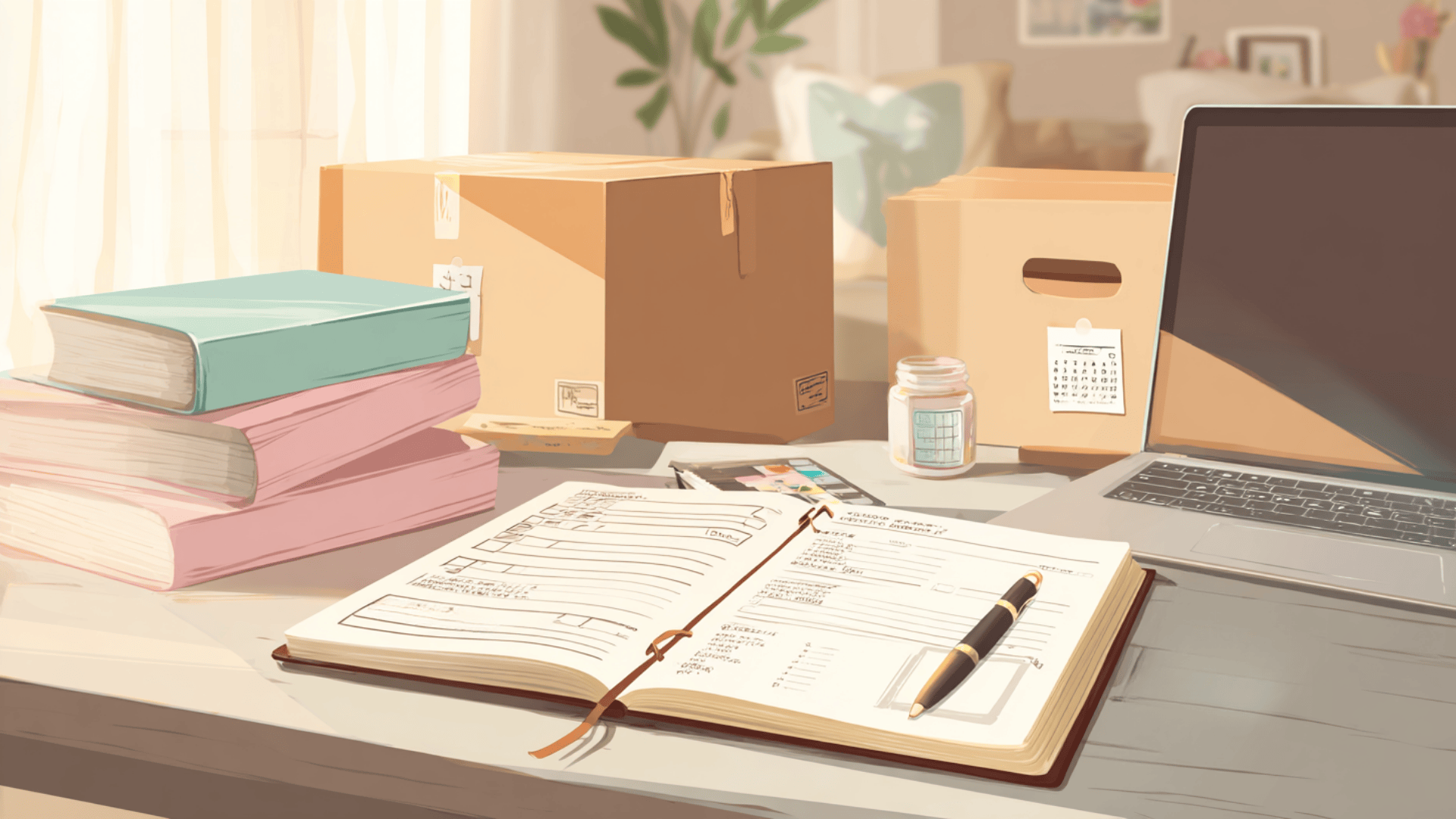
Moving involves more than just packing boxes-it’s a series of steps that unfold over time. This timeline checklist breaks down each stage so you can stay organized, reduce stress, and keep your move on track from start to finish.
1. Pre-Move Planning (8–4 Weeks Before Moving)
The earlier you start, the smoother your move will be. This stage is all about getting organized and setting a strong foundation for everything that comes next.
Declutter and Organize
- Sort by room: Go through each area and decide what stays or goes.
- Donate or sell items: Lighten the load by letting go of what you don’t need.
- Recycle or discard responsibly: Dispose of unwanted items properly.
- Create an inventory: List everything you’re taking to stay organized.
- Plan storage: Identify items that can be packed early or stored temporarily.
Budget and Book Services
- Set a moving budget: Include costs for movers, packing supplies, and cleaning.
- Get quotes: Compare estimates from multiple moving companies.
- Choose between DIY or full-service: Weigh effort versus cost before booking.
- Reserve early: Secure movers, trucks, or storage at least a month in advance.
- Plan moving insurance: Protect valuables in case of loss or damage.
To help you plan realistically, here’s a quick cost breakdown of common moving expenses so you can budget more accurately and avoid last-minute surprises:
| Expense | Estimated Cost | Details |
|---|---|---|
| Local movers (2–3 bedroom home) | $900–$2,000 | Includes labor and truck for a one-day move within 100 miles |
| Long-distance movers | $2,500–$6,000+ | Based on distance, weight, and services |
| Rental truck (DIY move) | $100–$300 per day | Add fuel, mileage, and insurance |
| Packing supplies | $150–$350 | Boxes, tape, bubble wrap, and markers |
| Packing services (optional) | $400–$1,000 | Professionals pack your belongings |
| Storage unit (1 month) | $75–$250 | Depends on unit size and location |
| Utility deposits and connection fees | $100–$400 | For electricity, gas, internet, and water |
| Cleaning service (move-out) | $100–$250 | Optional, but saves time and effort |
| Moving insurance | $100–$500 | Protects high-value or fragile items |
| Tips for movers | $20–$50 per mover | Based on service quality |
Notify and Schedule
- Update your address: File a change with USPS, banks, and insurance providers.
- Schedule utilities: Arrange shutoff and start dates for water, gas, and electricity.
- Inform key contacts: Notify your employer, landlord, and subscriptions.
- Plan time off work: Request vacation days around moving day if needed.
- Transfer services: Move internet, cable, and home security to your new address.
2. Packing and Preparation (3–1 Weeks Before)
As moving day gets closer, organization becomes key. This checklist helps you gather the right supplies, pack smart, and keep your essentials within easy reach for a smooth, stress-free transition:
Gather Supplies
- Collect packing materials: Stock up on boxes, tape, bubble wrap, and markers.
- Get specialty boxes: Use wardrobe or dish boxes for easier organization.
- Reuse supplies: Repurpose old boxes or borrow from friends to save money.
- Rent bins: Consider eco-friendly reusable bins for less waste.
- Keep tools handy: Have scissors, labels, and tape dispensers nearby.
Label and Prioritize
- Use color codes: Assign a color to each room for faster sorting.
- Mark contents: Write what’s inside and note if items are fragile.
- Pack non-essentials first: Start with décor, books, and out-of-season items.
- Leave daily-use items for last: Save kitchenware, toiletries, and bedding for the final days.
- Track progress: Check off packed rooms to stay organized.
Essentials Box and Important Documents
- Pack a 24-hour box: Include clothes, toiletries, snacks, and cleaning items.
- Keep records safe: Carry IDs, passports, and medical papers with you.
- Include tools: Add a basic toolkit, flashlight, and phone charger.
- Store medications separately: Keep them easily accessible during the move.
- Add comfort items: Toss in bedding or a coffee maker for quick setup.
3. Moving Day Checklist
Moving day can get hectic, but the right checklist keeps things under control. Use this as your moving to another state checklist or for a local move to stay organized and make the day smoother:
Protect and Supervise
- Lay floor protection: Use runners, mats, or cardboard to prevent scratches.
- Add wall guards: Shield corners and narrow hallways from dents.
- Guide movers: Be available to answer questions and direct loading.
- Label fragile items: Point out boxes that need extra care.
- Check room order: Make sure boxes go to the correct rooms.
Safety and Payments
- Keep valuables with you: Carry jewelry, cash, and important documents personally.
- Secure personal bag: Store essentials like chargers, snacks, and medications nearby.
- Confirm payment details: Review your moving contract before finalizing.
- Prepare tips: Have cash or digital payment ready for movers.
- Check mover inventory: Ensure all boxes are accounted for before signing off.
Final Walkthrough
- Inspect every room: Open closets, drawers, and cabinets before leaving.
- Check appliances: Look inside the washer, dryer, and fridge for forgotten items.
- Turn off utilities: Shut down lights, gas, and water if applicable.
- Lock up: Secure all doors and windows once movers are done.
- Take photos: Document property condition for rental or sale records.
- Confirm address change: Make sure mail is being forwarded to your new home.
4. After the Move (Settling In)
Once the boxes are in, it’s time to make your new place feel like home. Use this checklist to unpack efficiently, set up essentials, and get settled comfortably in your new neighborhood:
Unpack Strategically
- Start with essentials: Focus on bedrooms, kitchen, and bathroom first.
- Follow room order: Unpack one room at a time to avoid clutter.
- Set up sleeping spaces: Assemble beds and add fresh bedding for a good night’s rest.
- Organize kitchen basics: Arrange dishes, utensils, and appliances you use daily.
- Handle fragile boxes early: Check for damage and unpack breakables safely.
Set Up Essentials
- Connect utilities: Ensure water, gas, electricity, and internet are active.
- Test appliances: Confirm that major systems and devices work properly.
- Restock basics: Buy groceries, paper goods, and cleaning supplies.
- Dispose of packing materials: Recycle boxes and donate unused supplies.
- Plan your layout: Arrange furniture for flow and comfort before decorating.
Connect and Update
- Meet your neighbors: Introduce yourself to build community and safety.
- Locate key services: Find nearby grocery stores, pharmacies, and clinics.
- Update official records: Change address on driver’s license and voter registration.
- Check mail forwarding: Make sure your USPS change-of-address is working.
- Explore the area: Take a walk or drive around to get familiar with your new surroundings.
By breaking your move into clear stages, you can stay organized and stress-free from start to finish. Follow each checklist step-by-step, and settling into your new home will feel effortless.
Download Your Free Checklist for Moving
I’ve written everything down to keep you focused and stress-free. This free printable checklist includes every key step, from planning and packing to moving day and settling in, so you always know what comes next.
Use it to track your progress, manage your time, and stay organized throughout the process. Whether you’re moving across town or across the country, this checklist helps you stay on schedule and in control.
Extra Tools and Tips to Simplify Your Move
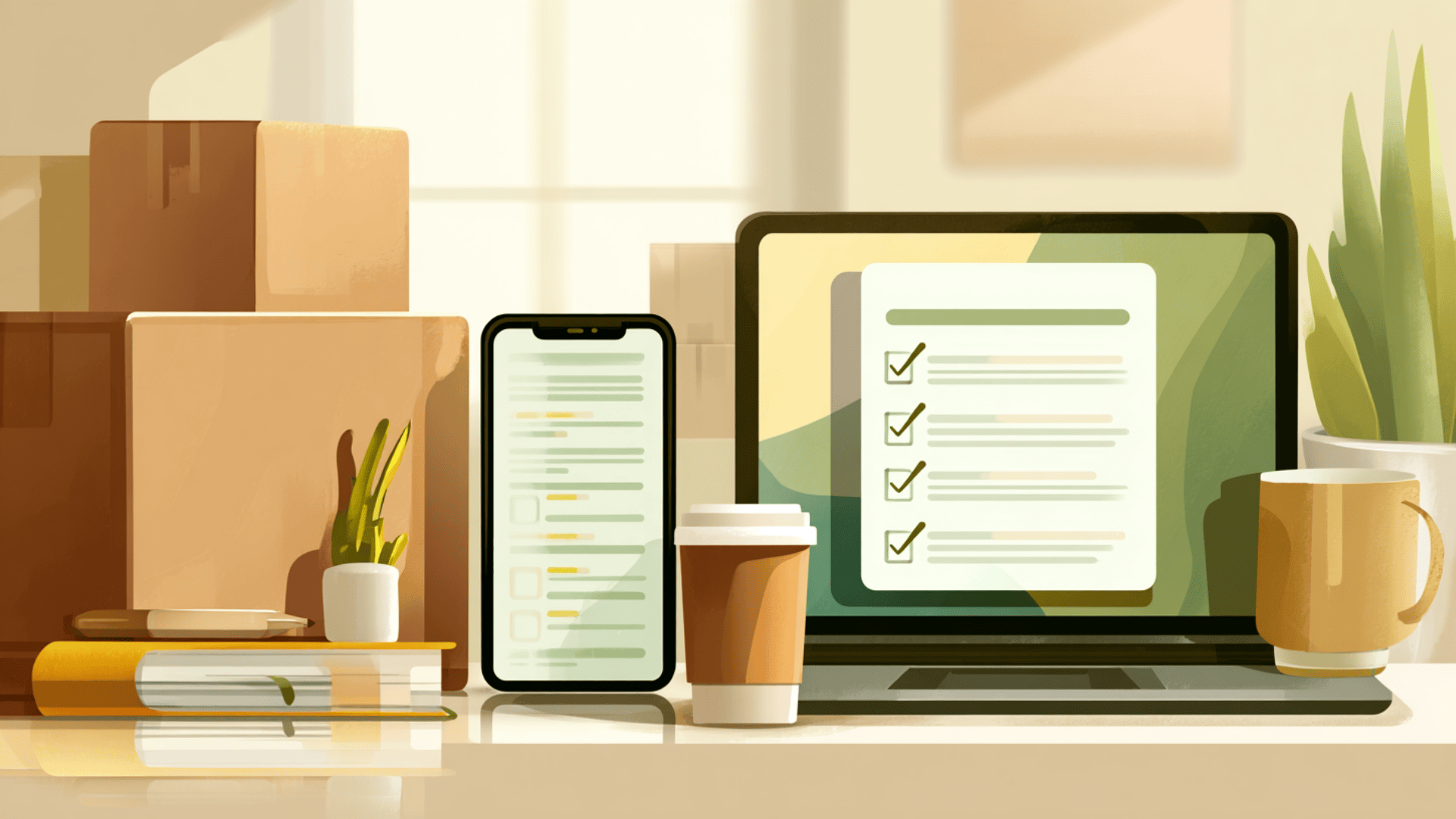
Moving Budget Calculator
Use tools like MoveAdvisor or Moving.com’s Cost Calculator to estimate total moving costs based on distance, home size, and services. They help you compare professional vs. DIY options and spot hidden expenses before moving day.
Apps for Organizing Your Move
Moving apps keep every task and box in order. Use them to track, plan, and stay on schedule without juggling paperwork:
- Sortly: Photograph and track what’s inside each box for easy unpacking.
- TaskRabbit: Find local help for packing, lifting, or furniture setup.
- Moving Planner: Manage tasks, reminders, and timelines all in one place.
Eco-Friendly Moving Tips
- Use reusable bins: Rent durable bins from Rentacrate instead of buying boxes.
- Pack with what you have: Use towels and clothes to protect fragile items.
- Recycle old supplies: Reuse or drop off boxes at local recycling centers.
- Donate unwanted items: Give usable goods to Goodwill or Habitat for Humanity.
- Choose green movers: Look for companies using biodiesel trucks or recycled materials.
With the right apps, calculators, and sustainable habits, moving doesn’t have to feel overwhelming. Use these tools to stay organized, save money, and settle into your new home responsibly.
Conclusion
Moving can be stressful, but with this checklist, you’ve already done the hard part: getting organized. You now have a clear plan that walks you through every stage, from early prep and packing to moving day and settling in.
You know what to expect, what to prioritize, and how to make the process smoother. I hope this checklist made things feel simpler and more doable for you.
Keep your checklist close, take things one step at a time, and you’ll be enjoying your new space before you know it!
